Home › Forums › Explore Media › Oil Pastels › Oil Pastel Library › Oil Pastel Tools and Materials › Getting Started in Oil Pastels: Tools & Materials
- This topic has 102 replies, 1 voice, and was last updated 2 years, 8 months ago by
 rosanticis.
rosanticis.
-
AuthorPosts
-
August 14, 2007 at 7:54 pm #448269
In this post, I’m going to introduce some tools and materials which you may find useful in painting with oil pastel. Pat will introduce a separate thread on techniques as soon as she gets her new studio operational. Please feel free to add your tips on materials and tools to this thread.
[FONT=Verdana] [/FONT]
[FONT=Verdana]Oil pastels[/FONT][FONT=Verdana] (OPs) are made from powdered pigments, wax, and non-drying mineral oil. The professional quality oil pastels are listed here, in order from softest and least waxy to hardest and most waxy. Note, though, that within a given line there is some variation in the softness between colours:[/FONT]
[FONT=Verdana] [/FONT]
[FONT=Verdana]Sennelier: the line comes in two sizes, regular, and Grande which are good for doing larger works.[/FONT]
[FONT=Verdana] [/FONT]
[FONT=Verdana]Holbein Artist: come in different values for the same hue. In their full set, the number of values is 5; when purchased individually, there are only 3 values available.[/FONT]
[FONT=Verdana] [/FONT]
[FONT=Verdana]Caran d’Ache Neopastels[/FONT]
[FONT=Verdana] [/FONT]
[FONT=Verdana]Cray-Pas Specialist [/FONT]
[FONT=Verdana] [/FONT]
Student grade OPs are also available, made cheaper in price by reducing the pigment load and increasing the wax content. Their waxy nature makes them harder to work with, and the reduction in pigment means that they will not have the colour saturation of professional OPs. Please note, to avoid purchasing their student grade OPs by mistake: Holbein makes a student grade which are round in shape, and Cray-Pas makes a student grade called Expressionist. We recommend that, if you can afford it, you start with professional quality OPs – the difference in handling is quite noticeable. The professional quality OPs are available individually or in sets.
[FONT=Verdana]Once you have purchased your OPs, you need a way to store them ready to use. If you buy a set, you may get an appropriate box. But, if you have more than one brand, you may want to integrate them, or you may need a way to store individually-purchased OPs. My solution was to purchase ArtBin pastel trays (they come three to an ArtBin box), in which I have integrated my Sennelier and Holbein OPs. I keep an empty tray on my drawing table, and when I am painting, I transfer the particular OPs I am using for the piece to it for convenience. Pat used to use plastic storage containers with lids for her OPs, separated by colour, and while painting, placed her active OPs on little plates. She has recently changed her storage method and will post a picture of her new pastel box when she sets up her studio.[/FONT]
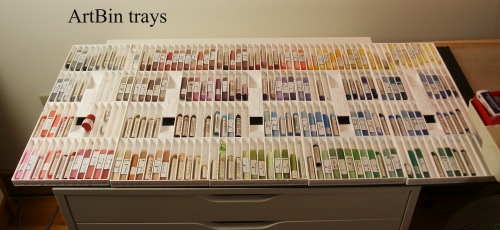
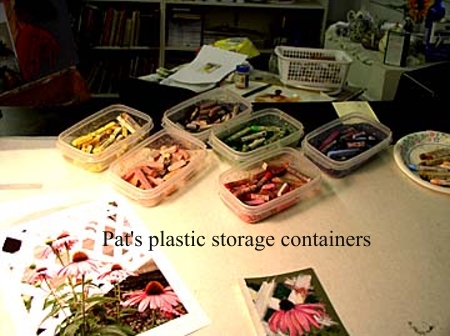
[FONT=Verdana]The choice of surface for your OPs is very important, as they behave differently on different surfaces. It pays to experiment with surfaces until you find ones you like. Some commonly used surfaces are: [/FONT]
[FONT=Verdana] [/FONT]
[FONT=Verdana]Art Spectrum Colourfix paper, which is 300gsm hot press watercolour paper coated with Colourfix primer. It has a fine-toothed texture and comes in a variety of colours. The primer may be purchased separately as well, and you can then coat your choice of support with it.[/FONT]
[FONT=Verdana] [/FONT]
[FONT=Verdana]Wallis sanded paper, which comes in white and Belgian mist (beige). This is available in professional and museum quality versions.[/FONT]
[FONT=Verdana] [/FONT]
[FONT=Verdana]Strathmore Bristol Vellum paper, which is a smooth white surface.[/FONT]
[FONT=Verdana] [/FONT]
[FONT=Verdana]Watercolour paper, available in hot press (smooth), cold press, and rough surfaces.[/FONT]
[FONT=Verdana] [/FONT]
[FONT=Verdana]Canvas board, which has a cross-weave texture.[/FONT]
[FONT=Verdana] [/FONT]
[FONT=Verdana]Masonite board, which has a smooth surface and should be gessoed.[/FONT]
[FONT=Verdana] [/FONT]
[FONT=Verdana]Mat and illustration board. Here the surface texture will depend on the choice of board.[/FONT]
[FONT=Verdana] [/FONT]
[FONT=Verdana]Smooth clayboard, which can be coated with Colourfix primer[/FONT]
[FONT=Verdana] [/FONT]
[FONT=Verdana]Canson pastel paper, which I find too flimsy for blending and layering OPs.[/FONT]
[FONT=Verdana] [/FONT]
[FONT=Verdana]Sennelier Oil Pastel Card, which I find has too marked a texture and don’t use.[/FONT]
[FONT=Verdana] [/FONT]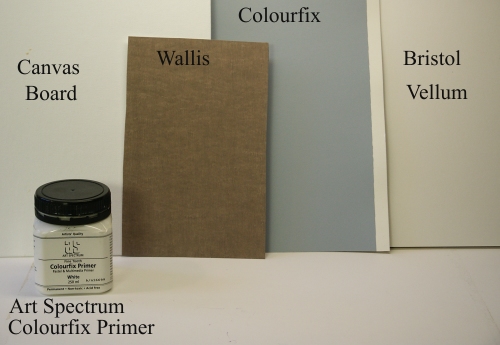
[FONT=Verdana]Blending of your Ops can be achieved in two ways: mechanical blending, or the use of mediums. Addressing mechanical blending first, the tools that can be used are:[/FONT]
[FONT=Verdana] [/FONT]
[FONT=Verdana]Colour shapers: I have several sizes of the Royal Sovereign firm (dark grey) colour shapers, which I use a lot. The light grey are too soft for this purpose. They can also be used to fill small areas if you scrape a bit of OP onto one corner and then transfer to your painting. I wipe my colour shapers with paper towels to keep them clean as I’m painting.[/FONT]
[FONT=Verdana] [/FONT]
[FONT=Verdana]Tortillons: are tightly-rolled paper, shaped to a pointed end, and serve the same purpose as colour shapers. They can be found in various sizes.[/FONT]
[FONT=Verdana] [/FONT]
[FONT=Verdana]Fingers: often the smoothest blend can be achieved by using your fingers, as the heat from your skin melts the OPs. To clean my fingers, I keep baby wipes handy. For large areas, I use a rubber finger available from a stationary store, to save wear and tear on my skin. Wallis sanded paper can abrade your skin if you’re not careful.[/FONT]
[FONT=Verdana] [/FONT]
[FONT=Verdana]It is also possible to use vinyl erasers and folded paper towels to blend. One oil pastellist who has fibromyalgia has reported using an electric toothbrush to blend her OPs, so be inventive and experiment.[/FONT]
[FONT=Verdana]Using mediums to blend is more like traditional painting in that you use a brush to smooth the ops over the surface. Various oil painting mediums will work, including odourless mineral spirits, turpentine or turpenoid, Weber’s Res-N-Gel, and Zest It, a non-toxic product available on-line from England. Note that, when you use mediums, you must use a surface which is appropriate for oils, such as canvas board, or coated papers such as Wallis or Colourfix, or one which has been primed with gesso.[/FONT]
[FONT=Verdana] [/FONT]
[FONT=Verdana]I usually apply the OPs first and then smooth and blend with a synthetic brush dipped in my medium of choice. To create an under-painting, you can brush your medium onto the surface first and work into that with your OPs, but this will thin the OP to a more washy consistency than the other method. A different way to use a medium, not involving a brush, is to dip your oil pastel into the medium before applying it to the surface. In all cases, there will be a waiting time for the medium to dry before you can proceed to add more OPs to the surface.[/FONT]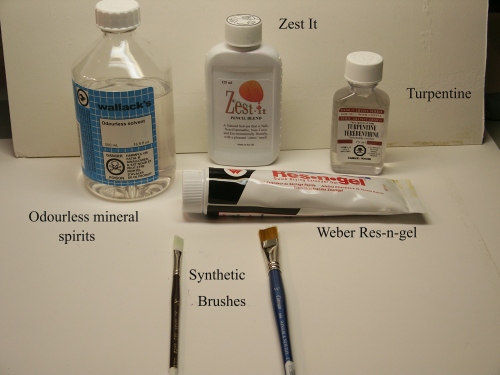
[FONT=Verdana]If you want to remove OPs from a surface, it can usually be done to a reasonable degree. In all cases, the best way to start is to scrape off the OP using a palette knife or single-sided razor blade. A kneaded eraser can then be used to pick up more of the OP. Finally, a Q-tip dipped in turpentine or odourless mineral spirits will help to remove most of the remaining OP. On a surface coated with acrylic gesso, I find that rubbing alcohol on a Q-tip will remove the OPs completely. Knifes and razor blades can also be used as painting tools when using the sgraffito technique to expose under-lying colours.[/FONT]
[FONT=Verdana] [/FONT]
[FONT=Verdana]I use Walnut Hollow oil pencils (available at Michaels craft stores) and Pitt and Carbothello pastels pencils to add small details at the end of a painting. These can also be used for your initial drawing and, by choosing an appropriate colour, you can avoid any problem of them mixing with and mudding your OPs. I’ve also illustrated a pastel holder which is useful when your oil pastel is worn to just a nub. They come in different sizes for different pastels.[/FONT]
[FONT=Verdana] [/FONT]
[FONT=Verdana]Since OPs contain a non-drying oil, they never completely dry, and can smudge and collect dust. To display your completed OP paintings, it is best to frame them under glass, using a mat or spacers to prevent the painting from touching the glass. To simply store them, you can apply Sennelier Oil Pastel fixative – I’ve found it requires three coats to prevent smudging. I didn’t notice any change in colour in the painting using this fixative, but it does make the surface quite shiny. You can also stack your OPs with wax paper or glassine paper between them. Marilynn Brandenburger is experimenting with framing her OPs like oils without glass. She applies four coats of Sennelier oil pastel fixative and then applies four coats of Golden varnish to protect her work. The longevity of this approach is still to be decided.[/FONT]
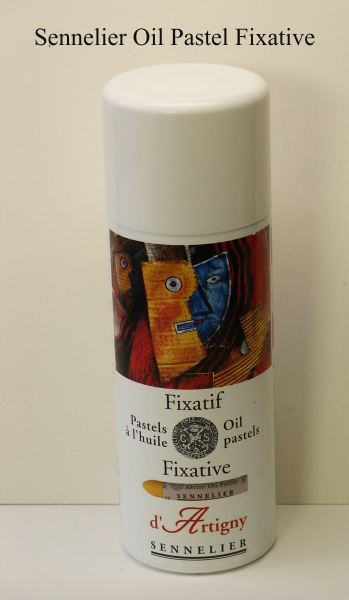
To finish, I thought I would mention sources of information on oil pastels. First and foremost is the Pastel Library here at Wet Canvas. Look for the thread “Oil Pastel index” on the first page and also check out the Oil Pastel Classrooms that have been done over time.
[FONT=Verdana] [/FONT]
[FONT=Verdana]At this point, there are no videos or DVDs available. The most easily accessible book is Oil Pastel for the Serious Beginner by John Elliot. A good source which is now out of print is Oil Pastel Materials and Methods by Kenneth Leslie – it may be available used or through interlibrary loan. There is a short chapter on OPs in The Pastel Book by Bill Creevy. There is a very introductory book by Jacqueline Black in the Learn to Paint series which I personally would not recommend.[/FONT]Hope this is useful. Jane
[FONT=Verdana][/FONT]
I am a member of the
 August 15, 2007 at 7:01 am #495286August 16, 2007 at 6:07 am #495359
August 15, 2007 at 7:01 am #495286August 16, 2007 at 6:07 am #495359I am new to wet canvas. I have been been building my portfolio of florals, my main passion. To tell you how long ago I started oil pastel, I still have a set of small grumbacher’s. I love senn. op’s but don’t really seem to get the greens I love, Pat, do you have any suggestions on greens, maybe holb. are better, truer hues or do you mix your own greens. I buy almost everything from ASW warehouse and they are out of alot but don’t carry Holb. in ope stock. Any sugesstions welcome, greens are so important to my work. thanks, Andi
Creating art is an obsesion for me, if I am obsessed, what bliss!
August 16, 2007 at 9:55 am #495287Welcome to WC and the oil pastel forum, Andi.:wave: I do a lot of florals also and have found a combination of Senn greens and Holbeins seems to work well for me. Jerry’s has open stock Holbeins. Here is a link http://www.jerrysartarama.com/art-supply-stores/online/1914.
I really like Senn #87 for some of the darks and I do add other colors into the darks, some reds, blues or purples, especially Senn #8.
Jane uses a lot of greens so maybe she can give you some advice too.Pat
My Website
oil pastel society member
my blog[/URL]
 August 16, 2007 at 10:07 am #495312
August 16, 2007 at 10:07 am #495312Hi Andrea and welcome to the Oil Pastel forum. Although you addressed your question to Pat, I thought I’d respond as well. For my landscapes, I generally use Sennelier Sap Green and Green Yellow Light, and Holbein Sap Green #1 and #3, Olive Green #1, Oxide of Olive #1 and #3, and Permanent Green #1 and #3. I also use some of the Sennelier brown/green neutrals as needed. I find I don’t use the blue greens or the brighter Holbein greens, such as May Green very often, but they are useful to have for certain circumstances. I don’t do florals that often so I can’t advise in that regard. I suspect you might want some of the brighter Holbein greens for them. You can buy individual Holbeins at Jerry’s Artarama (which owns ASW apparently) or at Dick Blicks. Hope this is useful. Jane
I am a member of the
 August 16, 2007 at 10:18 am #495360
August 16, 2007 at 10:18 am #495360Thank you very much. That is helpful. I like senn because I love to blend. Sometimes it is so daunting when looking at the numbers on hol but read on one of the threads how they worked, so thanks to all. I only asked Pat cause she had some florals on her site. I want to join the oil pastel society. I am so so excited that other artists are exploring this medium. I did not have any feedback for years! So great help. Thanks again. Andi
Creating art is an obsesion for me, if I am obsessed, what bliss!
August 16, 2007 at 10:24 am #495361Thanks to pat too! Still learning my way to finding posts and replies…I know you are very busy right now, prayers for your family. Will try all the suggestions here. Late would like to explore underpainting techniques with different mediums for underpainting. I have learned alot just reading these threads. You guys are great… Hope to post my latest work soon for critique…As soon as i figure out how…Ha. blessing, Andi:wave:
Creating art is an obsesion for me, if I am obsessed, what bliss!
August 16, 2007 at 3:08 pm #495336Andi: Welcome to WC! This is a wonderful place to be able to discuss issues with other OP artists – and there’s not that many of us, at least not yet! I’ll be looking forward to seeing the post of your work.

Jane: Whew! What an exhaustive list of OP tools and materials! Great job in assembling this and explaining it all. I’m impressed! :clap::clap: I’ve been meaning to post some photos I’ve got of tools, etc. that I use, but they’re not too accessible at the moment, so I’ll have to get them later.
For OP newbies: I think it’s important to point out that one can start with no more than a box of OPs and a piece of paper; it’s not at all necessary to amass all these different supplies before you can begin, and not all artists use all of them. And you can start with student grade materials, if that’s all you can afford at the beginning. It’s just that many of the student brands of OP are so hard that they don’t offer the wonderful experience of working with creamy sticks of pure color that makes OP painting so much of a pleasure – and so addicting!So don’t feel overwhelmed by the length of the list. Most of my own tools have been purchased one at a time as I feel I need them. If your budget is limited, you could always purchase a relatively good student set of OPs for the time being, (Mungyo Gallerys might be one, or Holbein or Van Gogh Student grade – keep in mind these aren’t necessarily archival, and they aren’t as easy to work with as the artist grade brands, but some nice work can still be produced with them), and along with them a stick or two of an artist grade OP, too, so you can see what the difference is. Then you could start purchasing sticks of artist grade OPs a few at a time. The student grade ones then could be retired to be used just for underpaintings once you collect enough of the artist grade OPs.
[FONT=Arial]C&C always welcome ©[/I] [/font]
[FONT=Palatino]
“Life is a pure flame and we live by an invisible sun within us.” ― Sir Thomas Browne [/size][/font]http://s3.amazonaws.com/wetcanvas-hdc/Community/images/29-Jul-2007/85002-sig-thumbnail_composite_2.jpg]/img]
August 16, 2007 at 7:56 pm #495307Thank you very much for the wonderful info. I am just going to start op’s and am interested in which brand to purchase. Have you ever hear of Mungyo and are they any good? I am looking forward to your reply and any other further info you have.
Thanks again.
DiAugust 16, 2007 at 8:09 pm #495362I think one of the other girls could tell you more but if you have no buget constraints, I would purchase senniliers or holbeins. If you are a starving artist like most of us, I found van gogh okay for student grade. They sell van gogh at dick blick.:clap:
Creating art is an obsesion for me, if I am obsessed, what bliss!
August 16, 2007 at 8:16 pm #495363Just an added thought. I started my daughter years ago with those and some regular school pencils with an eraser on the end for blending. I gave her some canson paper and let her go. Canson is reasonably priced too.
She loved it and had alot of exploration with them. I know the list they give seems large and unfamiliar but as you explore you will find new ways to use them. Glad you want to try, they are a wonderful medium. They are my main medium. I started when I was around 7 years old and never stoped1Creating art is an obsesion for me, if I am obsessed, what bliss!
August 16, 2007 at 8:51 pm #495313Di, welcome to the Oil Pastel forum. Mungyo are a student quality OP. Some people have managed to do OK with student brands, but I would personally recommend buying a small number of Senneliers to start. If you don’t have a local source, you can order them on-line from Loomis Art Supply in Montreal, thereby avoiding cross-border issues. That’s what I did (started with 19 Sennelier OPs) and became enamoured immediately. As soon as I could afford it, I bought more Senneliers and some Holbeins. The Island Blue on-line site (based in Vancouver ) carries Holbein Artist OPs. I have recently bought some Caran d’Ache which I also like, but I haven’t found a Canadian source for these. Hope that helps. Jane
I am a member of the
 August 16, 2007 at 9:14 pm #495337
August 16, 2007 at 9:14 pm #495337Hi Di, and welcome to the OP Forum!
 I’m glad to hear of your interest in OPs and hope you’ll come to love them as much as I do. About Mungyos and other student brands: I hesitated to make my earlier post, because there really is such an incredible difference between the student grades, such as Mungyos (also called Gallerys) and the artist brands. If you can at all afford to do so, I would definitely recommend that you begin with any of the four artist brands that Jane mentioned in the first post of this thread: Sennelier, Holbein (the square ones), Caran d’Ache or Sakura Specialists. They’re just so much easier to work with, and they’re easier to layer too; chances are you’ll be far more pleased with the results.
I’m glad to hear of your interest in OPs and hope you’ll come to love them as much as I do. About Mungyos and other student brands: I hesitated to make my earlier post, because there really is such an incredible difference between the student grades, such as Mungyos (also called Gallerys) and the artist brands. If you can at all afford to do so, I would definitely recommend that you begin with any of the four artist brands that Jane mentioned in the first post of this thread: Sennelier, Holbein (the square ones), Caran d’Ache or Sakura Specialists. They’re just so much easier to work with, and they’re easier to layer too; chances are you’ll be far more pleased with the results. But if money is a significant issue, try a student brand, and then start plotting and planning for ways to afford the good ones.
 Mungyo tends to be pretty hard, but has a pretty good color selection for a student brand. Some softer student brands than Mungyo are Van Goghs (they tend to be on the waxy side, but they offer tints (lighter values) and tones (darker values) of their basic colors, which is helpful), Holbeins (they also offer tints, and may offer tones), and Cray-Pas Expressionist (one of the softer student brands). I’d advise staying away from Pentel, Niji and the other super cheap sets. I offer this info because even with the less satisfactory student brands one can begin to get a feel for OPs, and do some OP painting. Even with the less-than-perfect materials, you’ll probably fall in love with OPs, as most of us here have, and want to move up to the artist brands as quickly as possible.
Mungyo tends to be pretty hard, but has a pretty good color selection for a student brand. Some softer student brands than Mungyo are Van Goghs (they tend to be on the waxy side, but they offer tints (lighter values) and tones (darker values) of their basic colors, which is helpful), Holbeins (they also offer tints, and may offer tones), and Cray-Pas Expressionist (one of the softer student brands). I’d advise staying away from Pentel, Niji and the other super cheap sets. I offer this info because even with the less satisfactory student brands one can begin to get a feel for OPs, and do some OP painting. Even with the less-than-perfect materials, you’ll probably fall in love with OPs, as most of us here have, and want to move up to the artist brands as quickly as possible. The danger with starting with a student brand though, is that you may find them so difficult to handle that you’ll decide you don’t like OPs, so that’s why I suggested buying one or two sticks of an artist brand in open stock, so that you can see what OPs are really capable of.
I cross posted here with Jane, who offers a good strategy – a very small Sennelier set would be preferable to a student set if you can afford it – watch for sales!
[FONT=Arial]C&C always welcome ©[/I] [/font]
[FONT=Palatino]
“Life is a pure flame and we live by an invisible sun within us.” ― Sir Thomas Browne [/size][/font]http://s3.amazonaws.com/wetcanvas-hdc/Community/images/29-Jul-2007/85002-sig-thumbnail_composite_2.jpg]/img]
August 17, 2007 at 1:00 am #495308AnnieA: Thank you for your quick reply. I am going to pick up a few of the artist brand in open stock and give them a whirl. I am really looking forward to trying them out. I am a soft pastellist ready, and willing to give another medium a go. Wish me luck.
Thanks again.
DiAugust 17, 2007 at 7:17 am #495288Wishing you luck and that is definitely the wway to go.
Pat
My Website
oil pastel society member
my blog[/URL]

-
AuthorPosts
- You must be logged in to reply to this topic.
Register For This Site
A password will be e-mailed to you.
Search